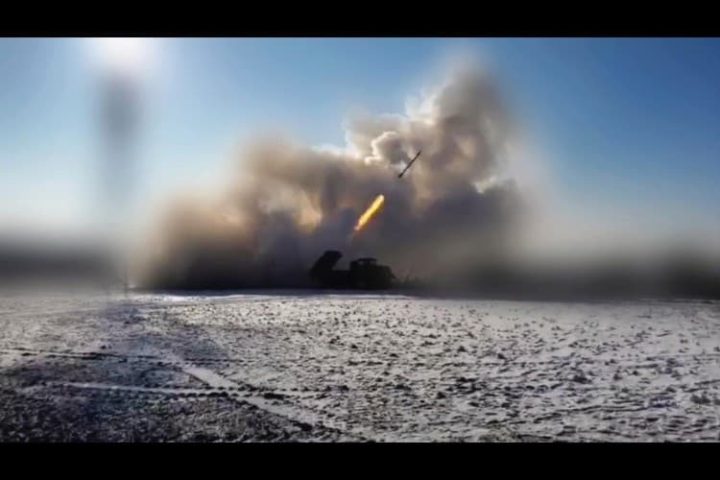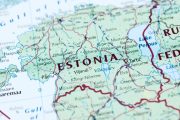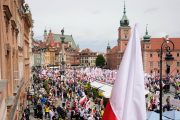
The city of Bakhmut in eastern Ukraine underwent heavy Russian artillery fire on February 13 in what seemed like a prologue to a key new offensive as the first anniversary of the conflict approaches.
Ukrainian soldiers, who have been defending the city for months, are ready for new ground attacks, according to Ukrainian military officials.
Positions in Bakhmut have been strengthened and only people with a military role are permitted in, a deputy battalion commander said. Any civilian who plans to leave the city would have to navigate Russian fire, he said.
Bakhmut is reportedly a major goal for Russian President Vladimir Putin, and its capture would offer Russia a new vantage point in the Donetsk region.
The Donetsk and Luhansk regions of eastern Ukraine comprise the Donbas, the country’s industrial heartland. Russia completely occupies the Luhansk region and occupies slightly more than half of the Donetsk region, and plans to gain full control.
In Brussels, NATO Secretary-General Jens Stoltenberg said he regarded the long-awaited Russian offensive to have already begun.
“We see no sign whatsoever that President Putin is preparing for peace,” he said ahead of a NATO defense minister’s meeting on Tuesday. “What we see is President Putin and Russia still wanting to control Ukraine. We see how they are sending more troops, more weapons, more capabilities,” he told reporters.
Supposedly, the Russian assault on Bakhmut has been led by mercenaries of the Wagner group, who have made small but steady gains. Moreover, renewed Russian bombardments have exacerbated the situation there.
“The city, the city’s suburbs, the entire perimeter, and essentially the entire Bakhmut direction and Kostyantynivka are under crazy, chaotic shelling,” said Volodymyr Nazarenko, deputy commander of Ukraine’s Soboda battalion.
Nazarenko said that while no fighting was taking place in the city center at the moment, the defenders were ready to face any attack.
“The city is a fortress — every position and every street there, almost every building, is a fortress.”
Earlier on Monday, the Russian defense ministry declared that its troops had advanced a few kilometers along the front lines, without indicating exactly where, in a war zone that entails several regions in the south and east.
The Ukrainian military reported heavy Russian shelling all along the front line and announced that 16 settlements had been attacked near Bakhmut. Besides, the military claimed that over the past day, its forces had fended off a number of attacks near Bakhmut, as well as bombardments in the Kharkiv, Luhansk, and Zaporizhzhia regions.
Luhansk Governor Serhiy Haidai said Russian forces had attacked Bilogorska from all sides before dawn on Monday.
“But our forces fought back there,” he told Ukrainian television. “It was the same situation in the direction of Kreminna — a lot of them [Russians] appeared there. But they pulled back after the fight with our forces.”
He elaborated, alluding to Russian actions: “Preparations for this offensive are already under way. The amount of shelling, air strikes and attacks by small groups has already increased. We are waiting for them to start massive round-the-clock attacks.”
Reuters was not able to independently verify the battlefield reports.
With Ukraine keen for more Western weapons and munitions in the hopes that they might change the course of the conflict, defense ministers from several NATO countries allied to Kyiv are poised to meet in Brussels on Tuesday to discuss potential further military aid.
Ukrainian Defense Minister Oleksii Reznikov said the main items on the agenda of the talks at NATO headquarters will be air defense, setting up a tank coalition, training of troops, and logistical support.
As incoming Russian bombardments were expected, Ukraine revealed that it needed fighter jets and long-range missiles to combat attacks and to recapture lost territory.
NATO’s Stoltenberg declared that he anticipated that the issue of aircraft would be discussed at the meeting. However, he conceded that such supplies would take time, whereas Ukraine required immediate ground support.
Additionally, Stoltenberg said that NATO needed “to ramp up production” of ammunition, as Ukraine’s rate of usage is greater than existing capacity and is draining stockpiles.
“The current rate of Ukraine’s ammunition expenditure is many times higher than our current rate of production. This puts our defense industries under strain.”
Stoltenberg acknowledged that NATO was facing a “problem,” as present waiting times for large-caliber ammunition have increased from 12 to 28 months.
Nonetheless, he said he was confident that existing measures meant NATO members were “on the path that will enable us both to continue to support Ukraine, but also to replenish our own stocks.”
Ukrainian Energy Minister German Galushchenko said Ukraine was meeting consumers’ energy demands after carrying out repairs to the national power network after the latest series of Russian air strikes.
Last week, Yevgeny Prigozhin, the head of Russia’s Wagner mercenary group, disclosed that it could take two years for Moscow to control the whole of two eastern Ukrainian regions whose capture it has stated as a major objective of the war.
Prigozhin said his comprehension of Russia’s plan was that it had to completely control the Donetsk and Luhansk regions that Moscow in 2022 annexed as republics of Russia, in a move slammed by most countries of the UN as unlawful.
“As far as I understand, we need to close off the Donetsk and Luhansk republics and, in principle, that will suit everyone for now,” he told Russian military blogger Semyon Pegov in a video published on Friday.
He said that process could take 1½ to two years.
“If we have to get to the Dnipro, then it will take about three years,” said Prigozhin, alluding to a larger area that would include the vast Dnipro River that runs roughly from north to south, bisecting Ukraine.
His remarks offered insight into Russian calculations of the likely duration of the conflict, from a man whose private army is at the crux of some of the fiercest fighting.
Although Prigozhin does not speak for the Russian military, he has greatly stepped up his comments in recent months, including by decrying the army leadership for its failures in nearly 12 months of conflict.
Yet he maintained that he harbored “zero” political ambitions.
Prigozhin said Russia needed to capture Bakhmut. When questioned if Russian forces were close to attaining a full blockade of the city, he said, “It is probably too early to say that we are close.
“There are many roads out and fewer roads in. Ukrainian troops are well-trained … and like any large city, it is impossible to capture it from head-on. We are managing very well.”
Based on U.S. intelligence, Wagner reportedly has about 50,000 personnel deployed to Ukraine at the moment, including 10,000 contractors and 40,000 convicts recruited from Russian prisons.
The United States has accused the group of committing widespread atrocities and human-rights violations, and labeled it as a transnational criminal group in January this year. In turn, Prigozhin dismissed U.S. accusations and asked Washington to “clarify” what crime Wagner was responsible for. Also, Prigozhin denied using former prisoners as cannon fodder and said casualties among prisoners were about the same in percentage terms as for the rest of his fighters.
The Ukraine-Russia conflict officially began on February 24, 2022. When Putin’s forces failed to secure an early end to the war in March, the conflict has since prolonged into a seeming war of attrition.



